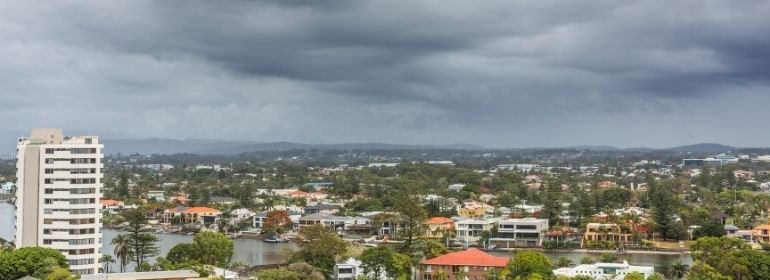16 April 2024

Are you and your home ready for storm season?
With the Australian summer comes storms. And storms can mean a whole host of damage to your property and your vehicles. Here are ten things you can do to minimise the risk of storms causing significant strife this summer.
1. Clean out your gutters
Storms equal high volumes of rainfall, and your guttering needs to be able to handle it. Clean out your guttering and downpipes to avoid water flowing back into your roof cavity, causing all sorts of damage.
2. Check out your roof
Broken tiles are an open invitation to rain and hailstones, so if your roof is tiled, take the time to carry out a thorough check of your tiles. Ensure you take the appropriate safety precaution or engage a professional tradesperson to assist. Replace any that are damaged.
3. Make sure your windows are sealed
Your window seals keep water out – if they’re damaged or deteriorated they’ll let water in! Replace the window seals if necessary.
4. Repaint exposed timber
Wooden window frames and wooden fascia boards need regular maintenance for them to last the course. If the paint is peeling, water will enter the wood and rotting will begin. So, give your exposed timber the once over. Peeling paint? Sand back and repaint – it’ll significantly prolong the life of your external wood.
5. Trim back your trees
Tree branches can be transformed into missiles during a storm, so cut back any that are too close to your home (within 10 metres) and lop off any dead branches from nearby trees too – high winds can easily take hold of them.
6. Look after outdoor furniture
If possible, store outdoor furniture under cover when not in use and, for those larger items – such as trampolines – peg them down to avoid becoming a local news story!
7. Sandbags at the ready!
In more flood-prone areas, it’s smart to have a few sandbags at the ready in case floodwaters surge towards your doors. A sump pump may also be a good addition to any basement areas.
8. Get your vehicles under cover
Hail damage to vehicles is a common issue during storm season, so if possible park under cover. Also, avoid parking in basement car parks. They are prone to flooding, so – whenever possible – park a level or two higher up.
9. Don’t take any risks while driving
If you’re driving when a storm begins, pull over in a safe spot and – if possible – take shelter. Never attempt to drive through a flooded area, we’ve all seen footage of cars stranded in rising water.
10. Stock up on essentials
If you’re in a remote or rural area, it’s smart to stock up on essentials. If a tree comes down your access could be cut off. Get an alternate power source – a generator, for example – in case the power’s cut off too. For those in particularly remote areas, a satellite phone is worth considering.
Take the time to create an emergency plan. Knowing what to do should a storm develop into an emergency, such as a flood, makes it easier to cope. For more information and resources visit your state’s emergency services website: New South Wales, Queensland, Victoria, South Australia, Western Australia, Northern Territory, Australian Capital Territory, Tasmania.
Now’s the time to double-check your insurance policies are valid and with adequate levels of cover – home, outbuildings, vehicles and contents. If you haven’t assessed your levels of cover for a while, make sure the values are correct. Repairs, especially those to a new building code, may have increased in price.
To review your personal insurance ahead of storm season and ensure you have the right level of cover in place, tailored to your personal situation, contact your local Elders Insurance Agent today.
Download a copy of our Storm Season Checklist
and prepare your property for storm season.
This factsheet was compiled based on information available to Elders Insurance on or before October 2020. The general advice in this factsheet has been prepared without taking into account your objectives, financial situation or needs. You must decide whether or not it is appropriate, in light of your own circumstances, to act on this advice. This guide does not form part of any insurance policy and is not used in the assessment of insurance claims. Any insurance claim will be assessed against the policy terms and conditions and applicable law.